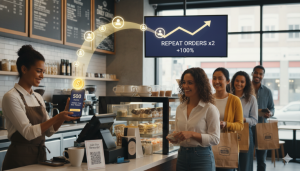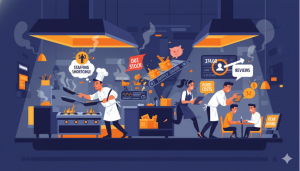In the sea of the food and beverage industry, your restaurant is but one little fish. In fact, this sea has approximately 15,000,000 restaurants, pubs, and cafes, and this is not taking into account the smaller unorganized businesses.
With so much competition how do you make your restaurant stand out and be recognizable to existing and potential customers?
We of course are talking about creating a branded restaurant app and improving brand recall.
A major way to create a branded restaurant and improve brand recall is to have the right platforms, that is a restaurant website and your own restaurant app.
Here is everything you need to know about creating a branded restaurant and using your own restaurant app to increase brand recall.
Improving Brand Recall with your Restaurant’s App

Creating a restaurant brand is a way to create a name for your business that ensures customers know they have come to the right place to meet their expectations and requirements.
Brand recall is when consumers think of your brand when asked about a product category. It ensures you have a strong customer base and thus business success.
In 2020, there were 3.6 billion smartphone users worldwide, a number which is expected to grow to 4.3 billion by the year 2023.
This number alone should indicate how important it is for your restaurant to have a smartphone presence. And what better way to have a smartphone presence than to have a dedicated restaurant app?
It has been said that customers need to be exposed to a brand at a minimum of 10 times before brand recall and awareness become somewhat automatic.
And while a website and other social media platform presence and marketing strategies are beneficial having your own restaurant app ensures exposure to your brand for customers at least once daily.
Customers need not use the app every day for it to improve brand recall. The icon on their smartphone is enough to generate brand awareness.
That said, this reiterates the fact that you need to create a name and logo that is memorable and unique so your app icon can stand out. We have spoken more about creating a brand and the naming and logo of your brand below.
The aim should be to have customers keep your restaurant app installed on your phone for as long as possible.
Besides generating constant exposure to your brand through the app icon, creating a restaurant app also offers the ability to send push notifications.
You can use your restaurant’s app to send notifications about different deals and promotions. These can be part of your marketing campaign. But, the notification itself also has value.
Such notifications create deeper brand resonance within your user’s mind thus improving brand recall.
Blink provides an online ordering solution for web interface but also for mobile applications including those available on iOS and Android.
Blink is offered as a Software-as-a-Service. The platform provides a secure scalable backend that is connected to a pre-designed, white-labeled template for your restaurant website and restaurant app.
The platform comes with a load of features including online ordering, payment options, administration tools, insights, and data, as well as operations features.
We will discuss some of these features below but to get a more comprehensive idea of what Blink can offer check out their feature set here, or book a demo with one of the restaurant consultants.
[INSERT_ELEMENTOR id=”2061″]
Top 4 Mistakes to Avoid When Using a Branded Restaurant App
If you are looking to create your own restaurant app through a team of developers, here are the top 4 mistakes to avoid.
1. Spending Too Little on Restaurant App Development:
Any developer can create a restaurant food ordering app for you, but it takes skill, time, and expensive resources to finish a fully functional application.
Since food business startups are strapped for money, they often spend too little on branded restaurant app development process. As a result, not only does the app lack basic features, but it also isn’t as polished as the next big competitor’s food app in the market.
Speaking of branded restaurant app’s cost, you need to have somewhere around $5500 to $10,000. Developers also charge a pretty penny for rolling out app updates, bug fixes, and maintenance patches.
To best deal with cost-related issues, it’s better to partner up with a reliable food aggregator with its own online food ordering application. This way, you won’t have to worry about creating your own restaurant ordering app, as most of your funds will be redirected to marketing campaigns, scalability operations, and vice versa.
2. Are You Sure It’s the Right Platform?
Depending on your audience demographics, make sure that you have either a white-labeled restaurant app through a food aggregator or a branded restaurant app for the right platform.
For instance, let’s say you have a restaurant chain in the U.S. If you choose to create a food ordering app for Android OS users, you are practically cutting yourself off from a wide majority of active iOS users around the country.
Likewise, if you have a food business in the Middle East, or Asia, think about increasing brand recall through a mobile app that is relevant to users’ platform of choice.
3. Excessive Ads and Information Overload:
While monetizing through ads on a food ordering app seems like a brilliant idea, don’t overdo it. Customers are annoyed by ads and if you continue to push unwanted advertisements their way, they’ll stop ordering from you.
Likewise, when you are looking to create your own restaurant app, keep your UI, UX, and food order menu simple. Food lovers are normally easy-going people.
Nothing pleases customers more than a flawless online food ordering process bundled with a seamless checkout experience. Having too much information related to flavors, toppings and side menus often slow down the food ordering process for many people.
You can display options related to food flavor and such other things later down through a radio button options interface during the order checkout process. It’s a simple example of what most branded restaurant app companies are doing right now.
4. Food Ordering App Performance Issues:
Does your food order app drain the battery quickly? Is it resource-hungry, or slows down smartphones?
How about unexpected “hangs” while users are busy ordering food through your online food ordering application? Such issues not only cause customers to leave negative reviews about your branded restaurant app but also hinder the actual food ordering process.
Before launching a food ordering app, make sure that it’s tested and good to go. Hire Alpha and Beta testers to see how your app responds to different platforms, OS versions, and other things.
A better option is to partner up with food aggregators such as Blink Co. to take care of your restaurants’ online technology-related needs. Not only does Blink offer a white-labeled online food ordering application, but they are also known for touting out restaurant websites, dedicated back-end dashboards, and much more.
If you are a brand new F&B business owner, you can book a demo with Blink reps here.
Other Benefits of Launching Your Own Restaurant App
Apart from the ability to increase brand recall and create a branded restaurant, when you use Blink to create your own restaurant app you also gain a number of other benefits.
Loyalty Program

Loyalty programs are a means to incentivize your customers to keep supporting your business.
It is very common for businesses of all kinds to know to have some sort of loyalty card or program that you can sign up or register for, and it’s no different in the restaurant world.
However, certain loyalty programs for customers can be quite tiresome when they involve long and complicated registrations. They also lose impact when customers have to remember to keep a physical loyalty card when they visit.
With Blink creating your restaurant’s app, you have the option to allow registered users to be offered a certain percentage of loyalty points on every purchase.
Customers can earn loyalty points on qualifying meal purchases on the app. The app also offers customers the ability to view their loyalty balance and use them to redeem through the app.
Thus, this takes away the hassle of complicated registrations as well as the requirement of your customers to carry physical loyalty cards to redeem offers. As a business, you are able to incentivize existing customers with ease.
Easier Ordering
Statistics show that orders placed through mobile apps and smartphones are growing and that they will make up 11% of all quick-service restaurant sales becoming a $38 billion industry.
With Blink, you can use this increasing trend by owning your own restaurant app and encouraging the new generation to order from your business.
Having your own app allows users to connect with your restaurant by being able to browse available menu items in restaurant branches near them.
Users have the option to select between picking up and order or having it delivered.
This type of ordering is not only chosen because people prefer to eat at home but is also more convenient in many aspects.
Online ordering takes away the hassle of ordering over the phone. It removes the issue of engaged telephone lines and miscommunicated orders which both pose a risk to creating a positive brand recall.
A major concern when offering online ordering for many restaurants is the user connection. However, with Blink’s simple designs positive user experience is guaranteed thus ensuring that your brand and customer experience is not compromised.
Better Payment Processing

While ordering through an app is well and good, it only makes proper sense when your customers also have the option to pay through the app.
While this is also beneficial to customers who order delivery, generating payment on the app is great for those customers that have chosen to pick up orders.
Having already paid through the app, you limit the risk of putting through orders that never get picked up. The process is simplified thus not requiring you to check whether an order being picked up has been paid for or not.
Moreover, the process of picking up the order becomes streamlined thus ensuring that there are not too many people gathered at the front of your restaurant trying to pay for their order.
Geo-Location Marketing

Having your own restaurant app offers the ability to avail geo-location marketing benefits.
With Blink’s restaurant apps, the user’s location is selected automatically and directs the customer to their nearest restaurant outlet.
This allows users to see what menu items are available for that particular branch but to also avail and special promotions or deals that are specific to a particular location.
Access to Useful User Data
Having your own restaurant app also allows you to gather information on your customers that can help you create meaningful marketing campaigns and better your business to provide the best user experience possible.
When using aggregator sites this element is lost and you also face the potential of your brand not putting forth the best user experience possible.
[INSERT_ELEMENTOR id=”2061″]
Creating Branded Restaurants
While having your own restaurant app is a great way to put forward your brand and improve brand recall, it is not the only element involved in the process of creating branded restaurants.
Your restaurant app is a major part of your brand identity but you need to ensure that all the elements of your restaurant and business work together to portray a cohesive brand that customers will associate with.
- Decide on your restaurant’s concept
The first step to creating a brand identity is to create a restaurant concept. You need to decide what type of restaurant you will be. This includes things such as the service style, the price range of your restaurant, and the formality level for example.
The concept of your restaurant should reflect what you want your brand to be.
You can also create a restaurant mission statement. This will outline what your restaurant’s values are and what you hope to achieve with your restaurant.
The mission statement is the connecting point between your business and its customer, staff, and stakeholders. This is also the statement that will help you decide on the other elements that make your brand.
- Decide who your target audience will be
You need to know which demographics you are targeting with your brand.
The type of people you consider your potential customers, including what their age is, what gender they are, and what income bracket they fall into plays a big role in your brand’s identity.
The location you are in also plays a big role in this.
Knowing your demographics ensures your brand can cater to your audience’s wants and likes. It also helps with deciding how you will market your brand.
- Your restaurant’s name and logo
A key element of your restaurant’s brand is its name. you want to choose something that while is unique is still memorable.
The name should not be something that is random and should encapsulate your brand and allow your potential customers to have a sense of what your restaurant offers both in relation to the food and atmosphere.
The logo is a visual representation of this name. the aim is to create something that customers will be able to recognize over time. Such as the golden arches of McDonald’s.
Try and create consistency by using a similar color palette and tone of the logo to the rest of your brand.
Remember, the name and logo will be displayed throughout and is the first exposure to your brand that all your potential and existing customers will see.
This name and logo will be on all marketing and advertising materials, signage, websites, apps, and menus.
- Restaurant vibe
The ambiance or atmosphere of your restaurant should also tie in with your overall brand to create a coherent branded restaurant.
Take into consideration things such as décor, color scheme, music, menu design, server composure, etc.
Your restaurant’s atmosphere is a physical representation of your brand. Having a restaurant for example that serves fast food but plays classical music will not create a cohesive branded restaurant.
- Digital marketing platforms, restaurant website, and restaurant app

It is an important part of creating a branded restaurant to keep your brand consistent on all platforms. This includes your restaurant’s website, your restaurant’s app, any social media platforms, and other marketing platforms you may use.
Whatever you post, whether it be pictures, the tone and language you use, the essence of your website, all express what your brand is.
Many times, the website is the first point of contact for potential customers of what your brand has to offer.
While Blink can help you create your restaurant’s app, they also offer the ability to create your restaurant’s website as well. You can ensure that your brand is being portrayed consistently without the hassle of launching a website or app independently.
Get the Most out of Your Branded Restaurant App
While creating a branded restaurant is not easy, taking the time to focus on each component of your brand and investing in creating a brand website and app allows your business better chances of success.
This endeavor will help your brand not only be recognizable but also appreciated by your potential and loyal customer base.
These elements allow your business to create a connection with its customers that can influence the success of your restaurant in the long run.
Related Articles:
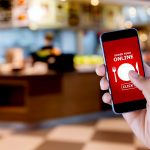 Here’s Why Custom Website for Restaurants Is a Game Changer In 2022
Here’s Why Custom Website for Restaurants Is a Game Changer In 2022
 5 Reasons Why Restaurant Online Ordering Platform is a Game Changer in 2021
5 Reasons Why Restaurant Online Ordering Platform is a Game Changer in 2021
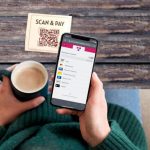 4 Best Electronic Ordering System (s) for Restaurant Businesses In 2021
4 Best Electronic Ordering System (s) for Restaurant Businesses In 2021
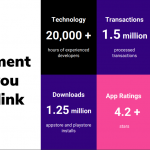 Our Guide to the Best Restaurant Management Software & What to Consider
Our Guide to the Best Restaurant Management Software & What to Consider
 How Blink Powers Businesses with Fast Order Fulfillment
How Blink Powers Businesses with Fast Order Fulfillment


